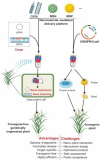CRISPR/Cas9 and Nanotechnology Pertinence in Agricultural Crop Refinement
- PMID: 35463432
- PMCID: PMC9024397
- DOI: 10.3389/fpls.2022.843575
CRISPR/Cas9 and Nanotechnology Pertinence in Agricultural Crop Refinement
Abstract
The CRISPR/Cas9 (Clustered Regularly Interspaced Short Palindromic Repeats/CRISPR-associated protein 9) method is a versatile technique that can be applied in crop refinement. Currently, the main reasons for declining agricultural yield are global warming, low rainfall, biotic and abiotic stresses, in addition to soil fertility issues caused by the use of harmful chemicals as fertilizers/additives. The declining yields can lead to inadequate supply of nutritional food as per global demand. Grains and horticultural crops including fruits, vegetables, and ornamental plants are crucial in sustaining human life. Genomic editing using CRISPR/Cas9 and nanotechnology has numerous advantages in crop development. Improving crop production using transgenic-free CRISPR/Cas9 technology and produced fertilizers, pesticides, and boosters for plants by adopting nanotechnology-based protocols can essentially overcome the universal food scarcity. This review briefly gives an overview on the potential applications of CRISPR/Cas9 and nanotechnology-based methods in developing the cultivation of major agricultural crops. In addition, the limitations and major challenges of genome editing in grains, vegetables, and fruits have been discussed in detail by emphasizing its applications in crop refinement strategy.
Keywords: Cas9; Cas9 activators; biotic and abiotic stress; horticultural crops; nano-fertilizers; nanoparticles; nutritional value.
Copyright © 2022 Naik, Shimoga, Kim, Manjulatha, Subramanyam Reddy, Palem, Kumar, Kim and Lee.
Conflict of interest statement
The authors declare that the research was conducted in the absence of any commercial or financial relationships that could be construed as a potential conflict of interest.
Figures




Similar articles
-
Nanotechnology and CRISPR/Cas9 system for sustainable agriculture.Environ Sci Pollut Res Int. 2023 Dec;30(56):118049-118064. doi: 10.1007/s11356-023-26482-8. Epub 2023 Mar 27. Environ Sci Pollut Res Int. 2023. PMID: 36973619 Review.
-
CRISPR/Cas9 Mediated Genome Engineering for Improvement of Horticultural Crops.Front Plant Sci. 2017 Sep 22;8:1635. doi: 10.3389/fpls.2017.01635. eCollection 2017. Front Plant Sci. 2017. PMID: 28970844 Free PMC article. Review.
-
Genome editing using CRISPR/Cas9-targeted mutagenesis: An opportunity for yield improvements of crop plants grown under environmental stresses.Plant Physiol Biochem. 2018 Oct;131:31-36. doi: 10.1016/j.plaphy.2018.03.012. Epub 2018 Mar 12. Plant Physiol Biochem. 2018. PMID: 29628199 Review.
-
Development of Improved Fruit, Vegetable, and Ornamental Crops Using the CRISPR/Cas9 Genome Editing Technique.Plants (Basel). 2019 Dec 13;8(12):601. doi: 10.3390/plants8120601. Plants (Basel). 2019. PMID: 31847196 Free PMC article. Review.
-
CRISPR/Cas technology for improving nutritional values in the agricultural sector: an update.Mol Biol Rep. 2022 Jul;49(7):7101-7110. doi: 10.1007/s11033-022-07523-w. Epub 2022 May 14. Mol Biol Rep. 2022. PMID: 35568789 Review.
Cited by
-
CRISPR/Cas genome editing system and its application in potato.Front Genet. 2023 Feb 13;14:1017388. doi: 10.3389/fgene.2023.1017388. eCollection 2023. Front Genet. 2023. PMID: 36861125 Free PMC article. Review.
-
Recent advances of CRISPR-based genome editing for enhancing staple crops.Front Plant Sci. 2024 Sep 23;15:1478398. doi: 10.3389/fpls.2024.1478398. eCollection 2024. Front Plant Sci. 2024. PMID: 39376239 Free PMC article. Review.
-
Preface to the special issue "Current Status and Future Prospects for the Development of Crop Varieties and Breeding Materials Using Genome Editing Technology".Plant Biotechnol (Tokyo). 2023 Sep 25;40(3):181-184. doi: 10.5511/plantbiotechnology.23.0000p. Plant Biotechnol (Tokyo). 2023. PMID: 38293252 Free PMC article. No abstract available.
-
CRISPR Variants for Gene Editing in Plants: Biosafety Risks and Future Directions.Int J Mol Sci. 2023 Nov 13;24(22):16241. doi: 10.3390/ijms242216241. Int J Mol Sci. 2023. PMID: 38003431 Free PMC article. Review.
-
Recalcitrance to transformation, a hindrance for genome editing of legumes.Front Genome Ed. 2023 Sep 21;5:1247815. doi: 10.3389/fgeed.2023.1247815. eCollection 2023. Front Genome Ed. 2023. PMID: 37810593 Free PMC article. Review.
References
Publication types
LinkOut - more resources
Full Text Sources

